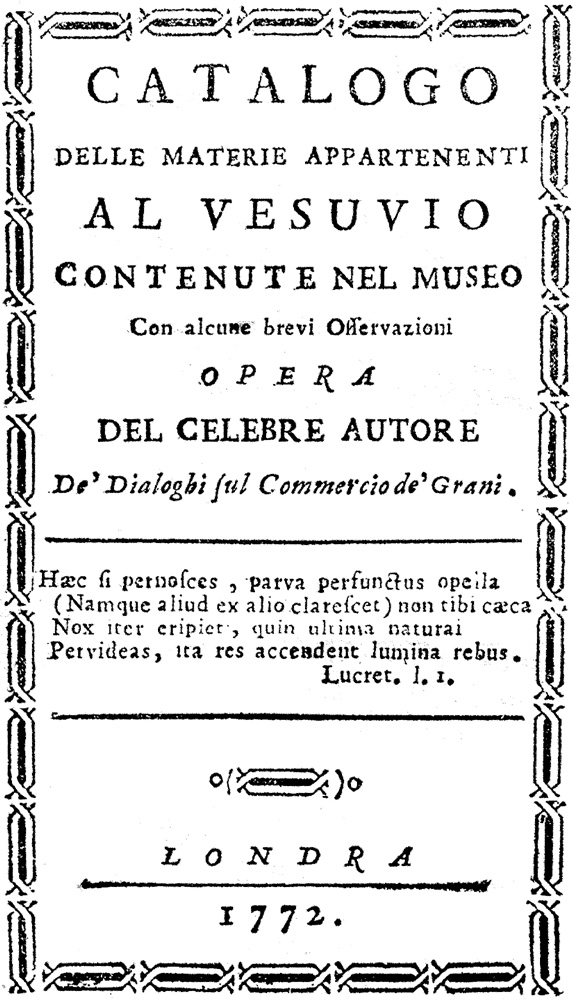GALIANI, Ferdinando.
(1728 – 1787)
Galiani wrote several works on natural history including in 1779 a book designed to calm the fears of Naples residents after an eruption of Vesuvius.
Biographical references: ABI: I 447, 281-328; II 261, 92-187; II S 36, 201. • Benvenuti, Dizionario degli Italiani all'Estero, 1890. • Capparoni, Profili Bio-Bibliografici, 1928-32. • Casati, Dizionario degli Scrittori d'Italia, 1925-34. • De Tipaldo, Biografia degli Italiani, 1834-45. • Imperatori, Dizionario di Italiani all'Estero, 1956. • Mieli, Gli Scienziati Italianì, 1921. • Nouvelle Biographie Générale (Hoefer): 19, cols. 230-7. • WBI.

1. Italian, 1772 [Collection catalog].
[Contained within an ornate box:] Catalogo | Delle Materie Appartenenti | Al Vesuvio | Contenute Nel Museo | Con alcune brevi Osservazioni | Opera | Del Celebre Autore | De' Dialoghi sul Commercio de' Grani. | [rule] | [...4 lines of quotation in Latin, signed Lucret ...] | [rule] | [ornament] | Londra | [rule] | 1772.
8°: viii, 184 p.
Rare. This is the earliest account of the varied volcanic ejecta found at Vesuvius. It is a descriptive catalog of 141 specimens contained in a mineralogical cabinet, and provides observations on the different minerals and rocks, and a method of classification based upon the degree of calcination of the specimen. Contained at the end is a valuable early bibliography of writings on Vesuvius.
The catalog gives details of the earliest mineralogical cabinet to describe the various ejecta of Mount Vesuvius and, together with Giovanni Maria della Torre's Storia e Fenomeni del Vesuvio (Napoli, 1755), provides the first ever descriptions of the volcano's minerals and rocks. It concludes with a 14 page bibliography of early works describing the volcano. In the history of mineralogy, Vesuvius is by far the most important volcano, as it alone was accessible to scientists in the eighteenth and nineteenth centuries. Thus, it was not only the source of rare and exceptionally beautiful minerals, but also facilitated the development of theories on mineral genesis. Later it was to become the birthplace of theoretical and practical vulcanology, when the world's first observatory was set up on the mountain's slopes in 1845.
Bibliographical references: Freilich Sale Catalog: no. 195. • Furchheim, Bibliografia del Vesuvio, 1897: p. 61. • Jonathan Hill, Bookseller: cat. 108 (1997), no. 40. • LKG: XIV 603. • NUC [no copy listed].
.